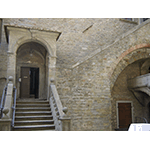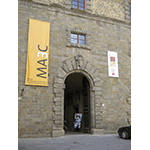Museo dell'Accademia Etrusca e della Cittą di Cortona [The Etruscan Academy Museum of the City of Cortona]
Originating as the "Society for the purchase of books" founded by the Venuti brothers in 1726, the Academy was constituted as the "Accademia di Scienze et Erudizioni" on November 9, 1727, the day on which the library and the museum of Abbot Onofrio Baldelli, a collector of naturalist specimens and Etruscan antiquities, was donated to it. In 1728, having become the "Accademia Etrusca delle Antichitą ed Iscrizioni", it represented a prime example of the cultural renewal of Tuscan culture that marked the first decades of the 18th century. In 1744, with the introduction of the so-called "Coritane Nights" – meetings held periodically among the members of the academy – the need was felt to study not only "physics" but also local history, antiquities and the arts. Accordingly, fossils and paleontological specimens, mineral and shells, destined to the Museum's Natural History Section, were presented and discussed.
The collections of the Museum, housed in Palazzo Casali, reflect the aims of the Academy. Visitors may follow three established itineraries (classical archaeology, Egyptian archaeology, and art history). From the collections, it is clear that the study, promotion and dissemination of natural history were important objectives of the Academy. The original core of the scientific material is the Baldelli collection, which includes naturalist specimens and some mathematical instruments. Particularly interesting are the pair of globes (terrestrial and celestial) dated 1714-15, purchased by Baldelli, and another celestial globe dated 1710.
The Library, annexed to the Museum, possesses a conspicuous heritage of books: very ancient and rare manuscripts, codexes and parchments dating from the 11th through the 19th century, rare printed texts from the 15th and 16th centuries and thousands of volumes from later times.
****************************
Texts by Anna Toscano
English translation by Catherine Frost
Last update 28/giu/2012





